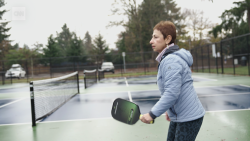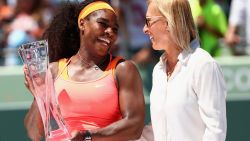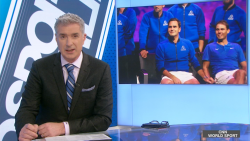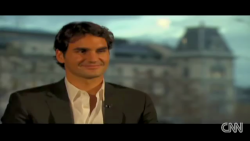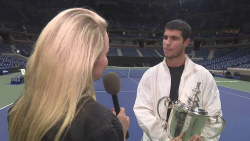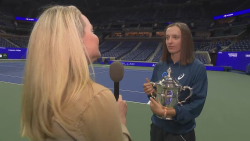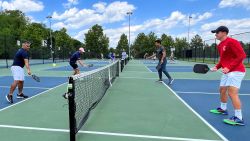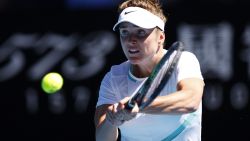As every parent knows, smartphones and screens can be a huge distraction for young children and teenagers.
But is the age of the smartphone, and being online at all hours of the day, beginning to affect the tennis world?
Some coaches think so.
During last month’s Wimbledon, Dr. Mark Kovacs, an American performance physiologist and coach who has worked with the likes of former US Open winner Sloane Stephens and Wimbledon marathon man John Isner, sent this tweet:
“Rafa, Roger, Novak were the last generation to grow up without cell phones as kids. Is this a possible reason why the new generation who are stronger, bigger, faster and younger still cannot find ways to beat them on a consistent basis?”
The 33-year-old Rafael Nadal, 38-year-old Roger Federer and 32-year-old Novak Djokovic have dominated the men’s game for the past 15 years.
The trio, best known as the “Big Three” have won 54 grand slam singles titles between them, including the last 11. Switzerland’s Stan Wawrinka was the last man outside of the “Big Three” to win a major, at the 2016 US Open. He’s 34 years old.
Although four players in the Top 10 on the ATP men’s tour are younger than 24, the sixth-ranked Alexander Zverev of Germany, world No. 7 Stefanos Tsitsipas of Greence, world No. 8 Daniil Medvedev and the ninth-ranked Karen Khachanov, both of Russia, have yet to make a breakthrough in any of the four tennis majors.
READ: Smartphone addiction could be changing your brain
Judy Murray
Kovacs’ message was retweeted by Judy Murray, the mother of former Wimbledon champions Andy and Jamie Murray, and a former player and British Fed Cup team captain herself.
Murray, who works regularly with young children as a coach, is worried that excessive time spent on electronic gadgets, smarthphones, tablets and other devices may affect the ability to concentrate.
“Tennis is so much about problem-solving, and working things out for yourself and thinking things through, and being able to understand what’s going on on your side of the net, but on the other side of the court as well,” Murray told CNN Sport in an interview at Wimbledon.
“You really need to think quickly and act quickly, so decision-making is such a huge part of it. And nowadays, there are just so many gadgets that do people’s thinking for them. It just worries me, the over-dependence on gadgets.”

David Sammel, head of the Bath Academy in Britain, agreed.
As the coach of New Zealand doubles player Marcus Daniell, 29, and British player Liam Broady, 25, Sammel has noticed a difference in mobile phone use between players who didn’t grow up with it, such as the “Big Three,” and the younger generation.
“I think it is a contributing factor to the longevity of Roger, Novak, Rafa, and some of the doubles players that are playing into their early 40s now,” Sammel told CNN Sport at Wimbledon.
“Some of them, I hardly ever see them on a phone when they are doing their work. And I know that some of them don’t have the phone on them when they are playing grand slams. And they let their team and people take care of things, and focus totally on what they’ve got to do.
“I certainly see young guys working hard in the gym, but between each set, they’re looking at their phones,” said Sammel, who is also the writer of “Locker Room Power: Buiding An Athlete’s Mind” about the mental aspects of playing tennis.
Best-of-five
The best-of-five scoring format in the men’s singles and doubles draws in the grand slams requires huge mental focus.
This year’s men’s final at Wimbledon between Federer and Djokovic lasted four hours, 57 minutes. Djokovic saved two match points before eventually winning the longest men’s final the All England Club had ever seen, 7-6 (7-5) 1-6 7-6 (7-4) 4-6, 13-12 (7-3).

“Over three sets, it’s easier to concentrate,” said Sammel. “And the big test is, not just five sets once, but you may have to do it two or three times to win a grand slam.
“Do they have the mental focus and resource to do that? It’s not just the fact they are on their phone, and scrolling on something like Instagram or something like that, you kind of almost go braindead for half an hour. It’s incessant,” he said.
“I am very aware of the danger of screens,” said Murray. “Not just physically, because obviously the whole sitting down, and the only thing that gets any exercise is your thumbs, but also socially, the whole lack of face-to-face interaction between kids and not just their peers, but the intergenerational communication and so forth.”
READ: Novak Djokovic calls 2019 Wimbledon win ‘mentally the most demanding’ of his career
‘Small margins’
Murray, who has guided many players at regional and national level as part of Britain’s Lawn Tennis Association’s programs, said she has seen a deterioration in recent years in the physical skills of young children in tennis clinics she gives around the world.
“I see so much of it in coaching,” said Murray. “Many more kids are coming into tennis without the basic coordination skills that we all used to develop naturally because we were outside playing freely.”

Although Sammel is aware of the ever-increasing importance of smartphones in players’ lives, for example, receiving important communication about tournaments or training via various electronic messaging platforms, he is surprised the younger generation aren’t following the lead of the older players.
“The margins are so small,” he said. “If there is any margin that you are giving away, why would you give it away?”



